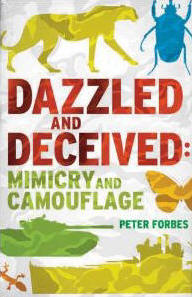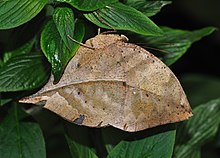
Camouflage is the use of any combination of materials, coloration, or illumination for concealment, either by making animals or objects hard to see, or by disguising them as something else. Examples include the leopard's spotted coat, the battledress of a modern soldier, and the leaf-mimic katydid's wings. A third approach, motion dazzle, confuses the observer with a conspicuous pattern, making the object visible but momentarily harder to locate, as well as making general aiming easier. The majority of camouflage methods aim for crypsis, often through a general resemblance to the background, high contrast disruptive coloration, eliminating shadow, and countershading. In the open ocean, where there is no background, the principal methods of camouflage are transparency, silvering, and countershading, while the ability to produce light is among other things used for counter-illumination on the undersides of cephalopods such as squid. Some animals, such as chameleons and octopuses, are capable of actively changing their skin pattern and colours, whether for camouflage or for signalling. It is possible that some plants use camouflage to evade being eaten by herbivores.

Batesian mimicry is a form of mimicry where a harmless species has evolved to imitate the warning signals of a harmful species directed at a predator of them both. It is named after the English naturalist Henry Walter Bates, who worked on butterflies in the rainforests of Brazil.

Dazzle camouflage, also known as razzle dazzle or dazzle painting, is a family of ship camouflage that was used extensively in World War I, and to a lesser extent in World War II and afterwards. Credited to the British marine artist Norman Wilkinson, though with a rejected prior claim by the zoologist John Graham Kerr, it consisted of complex patterns of geometric shapes in contrasting colours interrupting and intersecting each other.

Müllerian mimicry is a natural phenomenon in which two or more well-defended species, often foul-tasting and sharing common predators, have come to mimic each other's honest warning signals, to their mutual benefit. The benefit to Müllerian mimics is that predators only need one unpleasant encounter with one member of a set of Müllerian mimics, and thereafter avoid all similar coloration, whether or not it belongs to the same species as the initial encounter. It is named after the German naturalist Fritz Müller, who first proposed the concept in 1878, supporting his theory with the first mathematical model of frequency-dependent selection, one of the first such models anywhere in biology.

Military camouflage is the use of camouflage by an armed force to protect personnel and equipment from observation by enemy forces. In practice, this means applying colour and materials to military equipment of all kinds, including vehicles, ships, aircraft, gun positions and battledress, either to conceal it from observation (crypsis), or to make it appear as something else (mimicry). The French slang word camouflage came into common English usage during World War I when the concept of visual deception developed into an essential part of modern military tactics. In that war, long-range artillery and observation from the air combined to expand the field of fire, and camouflage was widely used to decrease the danger of being targeted or enable surprise. As such, military camouflage is a form of military deception in addition to cultural functions such as political identification.
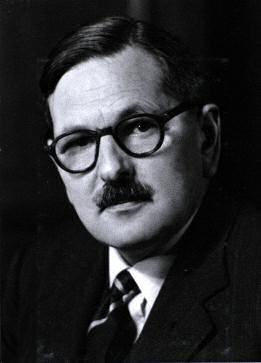
Hugh Bamford Cott was a British zoologist, an authority on both natural and military camouflage, and a scientific illustrator and photographer. Many of his field studies took place in Africa, where he was especially interested in the Nile crocodile, the evolution of pattern and colour in animals. During the Second World War, Cott worked as a camouflage expert for the British Army and helped to influence War Office policy on camouflage. His book Adaptive Coloration in Animals (1940), popular among serving soldiers, was the major textbook on camouflage in zoology of the twentieth century. After the war, he became a Fellow of Selwyn College, Cambridge. As a Fellow of the Zoological Society of London, he undertook expeditions to Africa and the Amazon to collect specimens, mainly reptiles and amphibians.
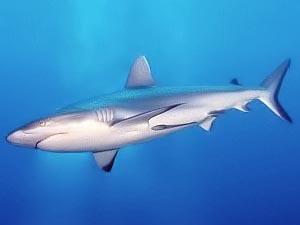
Countershading, or Thayer's law, is a method of camouflage in which an animal's coloration is darker on the top or upper side and lighter on the underside of the body. This pattern is found in many species of mammals, reptiles, birds, fish, and insects, both in predators and in prey.

Sir John Graham Kerr, known to his friends as Graham Kerr, was a British embryologist and Unionist Member of Parliament (MP). He is best known for his studies of the embryology of lungfishes. He was involved in ship camouflage in the First World War, and through his pupil Hugh B. Cott influenced military camouflage thinking in the Second World War also.

Animal colouration is the general appearance of an animal resulting from the reflection or emission of light from its surfaces. Some animals are brightly coloured, while others are hard to see. In some species, such as the peafowl, the male has strong patterns, conspicuous colours and is iridescent, while the female is far less visible.
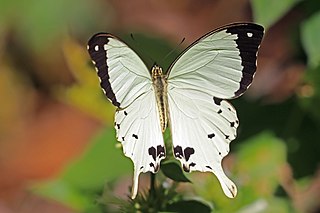
Парусник Дардан, the Saharan swallowtail,African swallowtail, mocker swallowtail or flying handkerchief, is a species of butterfly in the family Papilionidae. The species is broadly distributed throughout Sub-Saharan Africa. The British entomologist E. B. Poulton described it as "the most interesting butterfly in the world".

Geoffrey Barkas was an English filmmaker active between the World War I and World War II. Barkas led the British Middle East Command Camouflage Directorate in the Second World War. His largest "film set" was Operation Bertram, the army-scale deception for the battle of El Alamein in October 1942.

Disruptive coloration is a form of camouflage that works by breaking up the outlines of an animal, soldier or military hardware with a strongly contrasting pattern. It is often combined with other methods of crypsis including background colour matching and countershading; special cases are coincident disruptive coloration and the disruptive eye mask seen in some fishes, amphibians, and reptiles. It appears paradoxical as a way of not being seen, since disruption of outlines depends on high contrast, so the patches of colour are themselves conspicuous.

The British Middle East Command Camouflage Directorate organised major deception operations for Middle East Command in the Western Desert Campaign of the Second World War. It provided camouflage during the siege of Tobruk; a dummy railhead at Misheifa, and the largest of all, Operation Bertram, the army-scale deception for the decisive battle of El Alamein in October 1942. The successful deception was praised publicly by Winston Churchill.
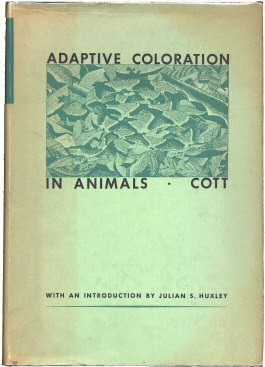
Adaptive Coloration in Animals is a 500-page textbook about camouflage, warning coloration and mimicry by the Cambridge zoologist Hugh Cott, first published during the Second World War in 1940; the book sold widely and made him famous.

Concealing-Coloration in the Animal Kingdom: An Exposition of the Laws of Disguise Through Color and Pattern; Being a Summary of Abbott H. Thayer's Discoveries is a book published ostensibly by Gerald H. Thayer in 1909, and revised in 1918, but in fact a collaboration with and completion of his father Abbott Handerson Thayer's major work.

Animal Coloration, or in full Animal Coloration: An Account of the Principal Facts and Theories Relating to the Colours and Markings of Animals, is a book by the English zoologist Frank Evers Beddard, published by Swan Sonnenschein in 1892. It formed part of the ongoing debate amongst zoologists about the relevance of Charles Darwin's theory of natural selection to the observed appearance, structure, and behaviour of animals, and vice versa.
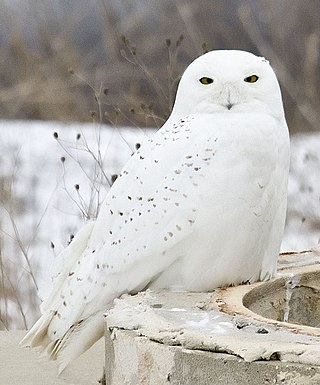
Distractive markings serve to camouflage animals or military vehicles by drawing the observer's attention away from the object as a whole, such as noticing its outline. This delays recognition. The markings necessarily have high contrast and are thus in themselves conspicuous. The mechanism therefore relies, as does camouflage as a whole, on deceiving the cognition of the observer, not in blending with the background.

Self-decoration camouflage is a method of camouflage in which animals or soldiers select materials, sometimes living, from the environment and attach these to themselves for concealment.
